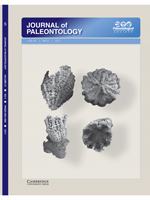The mixed carbonate-siliciclastic successions of the Cambrian Series 2–Cambrian Series 3 interval of the Great Basin are well investigated in respect to their trilobite and brachiopod fauna. In contrast, the small shelly fossils have been mostly unreported. Nine sections in eastern California and southern Nevada have produced a small shelly assemblage of low diversity, which likely reflects non-phosphatization and loss of originally calcareous remains. From the Montezuman—Delamaran stages we report Anabarella chelata Skovsted, 2006a, Costipelagiella nevadense Skovsted, 2006a, Pelagiella aff. P. subangulata (Tate, 1892), Microcornus sp., Parkula sp., Hyolithellus? sp., Allonia sp., Chancelloria sp., Archiasterella cf. A. hirundo Bengtson in Bengtson et al., 1990, Archaeooides cf. A. granulatus Qian, 1977, and undefined echinoderms and helcionelloid molluscs. The lower part of the Montezuman Stage delivered a number of lobopodian sclerites as Microdictyon rhomboidale Bengtson, Matthews, and Missarzhevsky, 1986, Microdictyon montezumaensis n. sp., and Microdictyon cuneum n. sp. The occurrence of P. aff. P. subangulata and species of Microdictyon in the lower Montezuman Stage offers a fundamental potential for correlation with the base of Cambrian Series 2/Stage 3 of South China, Siberia, and Avalonia.
How to translate text using browser tools
1 September 2017
Small shelly fossils from the Montezuman—Delamaran of the Great Basin in Nevada and California
Thomas Wotte,
Frederick A. Sundberg
ACCESS THE FULL ARTICLE

Journal of Paleontology
Vol. 91 • No. 5
September 2017
Vol. 91 • No. 5
September 2017




